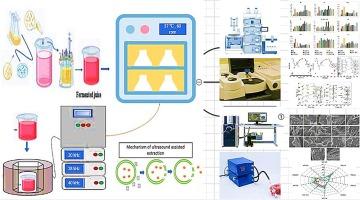多频声波发酵与单培养基和共培养基 LAB 协同增产桑果汁:来自代谢、微观形态、感官和计算方法的证据。
IF 8.7
1区 化学
Q1 ACOUSTICS
引用次数: 0
摘要
评价了多频超声波辅助(20/28/40 KHz)发酵(单培养和共培养)对桑椹汁的代谢、结构、微形态和感官特性的影响。结果表明,多频超声波辅助发酵显著改变了桑果汁粉的微观结构,使其表面更多孔、更粗糙,并带有不规则的压痕。表现最好的样品(S10)的总酚含量增至 365.36 毫克 GAE/毫升,总黄酮含量增至 139.20 毫克 RE/毫升(p本文章由计算机程序翻译,如有差异,请以英文原文为准。

Multi-frequency sono-fermentation with mono and co-cultures of LAB synergistically enhance mulberry juice: Evidence from metabolic, micromorphological, sensorial, and computational approaches
The effect of multi-frequency ultrasound-assisted (20/28/40 KHz) lactic acid bacteria (LAB- Lacticaseibacillus casei, Lactiplantibacillus plantarum, Lacticaseibacillus paracasei, Lactobacillus acidophilus, and Lactobacillus helveticus) fermentation (mono and co-cultures) on the metabolic, structural, micromorphological, and sensorial properties of mulberry juice were evaluated. Results indicated that multi-frequency ultrasound-assisted fermentation significantly modified the microstructure of mulberry juice powder, resulting in more porous and rougher surfaces with irregular indentations. Total phenolic content in the best-performing sample (S10) increased to 365.36 mg GAE/mL, while total flavonoid content rose to 139.20 mg RE/mL (p < 0.05). Antioxidant activity, as measured by DPPH and FRAP assays, also showed considerable improvement, with DPPH scavenging activity increasing to 87.45 % and FRAP-value to 3.27 mM TE/mL (p < 0.05). Additionally, HPLC-UV analysis revealed that the amendment in the concentrations of cyanidin-3-rutinoside (47.47 mg/L) and peonidin-3-O-glucoside (66.86 mg/L) in the S2-based sample. E-nose analysis demonstrated intense flavor profiles in fermented samples, particularly in sample S15. Sensory evaluation also highlighted that the fruity and floral aromas in co-culture fermented samples were enhanced, notably in S10, S7, and S14. Thus, combining multifrequency ultrasonication and fermentation significantly enhances the antioxidants capacity, flavor profile, micro-morphology, and overall quality of mulberry juice.
求助全文
通过发布文献求助,成功后即可免费获取论文全文。
去求助
来源期刊

Ultrasonics Sonochemistry
化学-化学综合
CiteScore
15.80
自引率
11.90%
发文量
361
审稿时长
59 days
期刊介绍:
Ultrasonics Sonochemistry stands as a premier international journal dedicated to the publication of high-quality research articles primarily focusing on chemical reactions and reactors induced by ultrasonic waves, known as sonochemistry. Beyond chemical reactions, the journal also welcomes contributions related to cavitation-induced events and processing, including sonoluminescence, and the transformation of materials on chemical, physical, and biological levels.
Since its inception in 1994, Ultrasonics Sonochemistry has consistently maintained a top ranking in the "Acoustics" category, reflecting its esteemed reputation in the field. The journal publishes exceptional papers covering various areas of ultrasonics and sonochemistry. Its contributions are highly regarded by both academia and industry stakeholders, demonstrating its relevance and impact in advancing research and innovation.
 求助内容:
求助内容: 应助结果提醒方式:
应助结果提醒方式:


